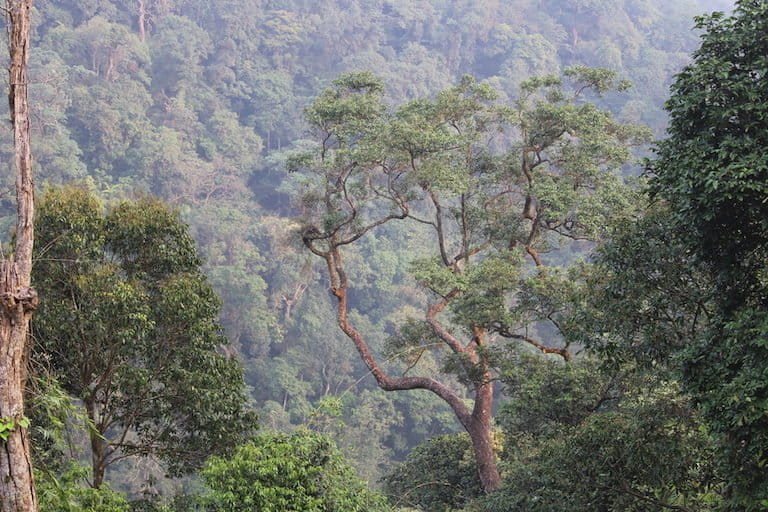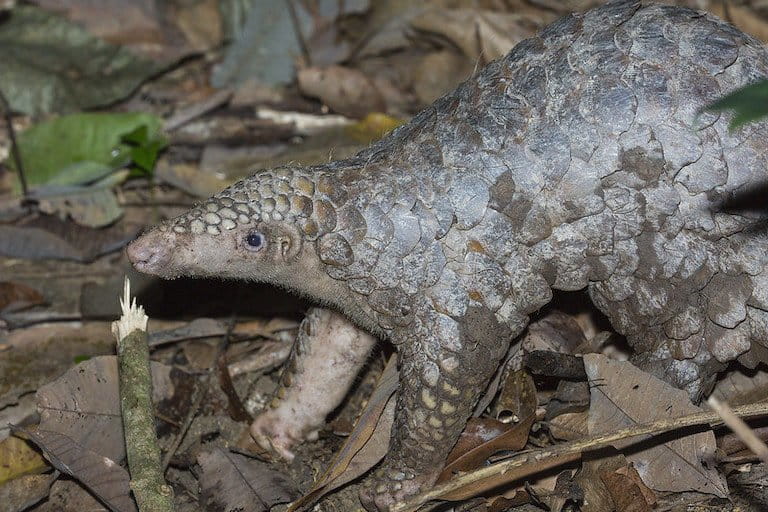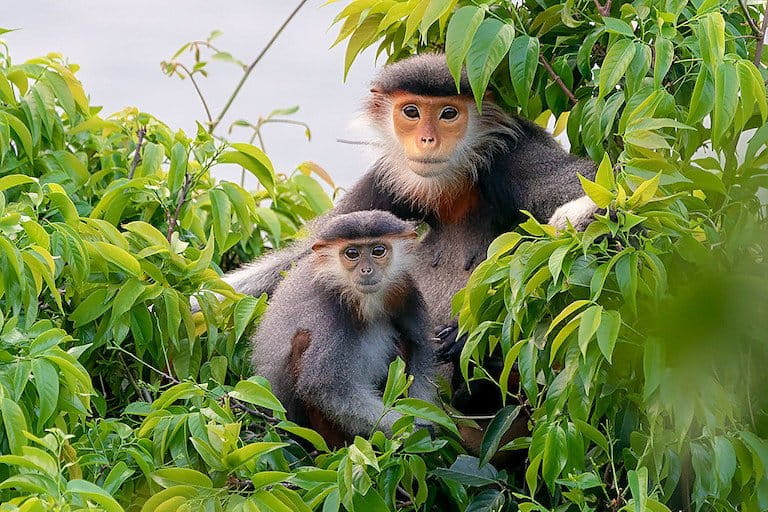- Conservationists have hailed the establishment of the new Dong Chau-Khe Nuoc Trong Nature Reserve as a major step for the protection of Vietnam’s wildlife.
- The new reserve is home to a number of threatened species, including two species of muntjac deer (Muntiacus vuquangensis and M. truongsonensis), the Annamite striped rabbit (Nesolagus timminsi), the Sunda pangolin (Manis javanica), the southern white-cheeked gibbon (Nomascus siki), the red-shanked douc langur (Pygathrix nemaeus), and the crested argus (Rheinardia ocellata), which resembles a peacock.
- Conservationists debate whether it may also shelter the saola (Pseudoryx nghetinhensis), a mysterious antelope-like bovine so rare it has been called the “Asian unicorn.”
- Critical threats such as poaching and deforestation remain, however, and conservationists say enforcement of new protective measures will be key to the reserve’s success.
HO CHI MINH CITY — In a move wildlife conservationists are hailing as a victory, Vietnam has established a new nature reserve encompassing critical habitat for numerous species, several of them threatened globally with extinction.
Located in Quang Binh province in central Vietnam, the Dong Chau-Khe Nuoc Trong Nature Reserve spans 22,132 hectares (54,689 acres) of lowland evergreen forests in the Truong Son Mountains, known internationally as the Annamite Mountains. The area sits to the south of Phong Nha-Ke Bang National Park, home to the world’s largest known cave. The name of the new reserve, whose creation was first reported by state media in July, means “clear water in the ravine” in Vietnamese.
“In theory, as a nature reserve, Khe Nuoc Trong will have the highest level of protection, including no resource extraction and no tourists in strictly protected ecological rehabilitation zones,” Trang Nguyen, founder of the Hanoi-based wildlife conservation group WildAct, told Mongabay. The area was previously administered as a watershed protection forest.

Lobbying for the creation of the reserve was spearheaded by Viet Nature Conservation Centre, an NGO based in Hanoi, with support from several international conservation organizations. Pham Tuan Anh, Viet Nature’s president and co-founder, said her group and its predecessor, BirdLife Vietnam Programme, have been working in the region for about two decades.
According to Tuan Anh, threatened species thought to be living in the new reserve include the saola (Pseudoryx nghetinhensis), two species of muntjac deer (Muntiacus vuquangensis and M. truongsonensis), the Annamite striped rabbit (Nesolagus timminsi), the Sunda pangolin (Manis javanica), the southern white-cheeked gibbon (Nomascus siki), the red-shanked douc langur (Pygathrix nemaeus), and the crested argus (Rheinardia ocellata), which resembles a drab peacock.
The forest is also within the historical range of the endemic, critically endangered Edwards’s pheasant (Lophura edwardsi), a bird species that may be functionally extinct in the wild. “There are plans to reintroduce this species and a very strong team for [its] recovery” inside Khe Nuoc Trong, Tuan Anh said.

The saola, a mysterious antelope-like bovine with a pair of long, straight horns, is of particular interest. The species was scientifically described based on remains found in 1992, and is so rare it has been called the “Asian unicorn.”
Tuan Anh said a team from BirdLife Vietnam Programme found the remains of a saola killed by hunters in Khe Nuoc Trong in 2002, and that Viet Nature’s camera traps and surveys of the forest over the past decade “show very strong hope for the saola to persist there.”
Nguyen, however, argues against confidence that the saola may be found in Khe Nuoc Trong. “I think it’s a misleading claim to attract people’s attention as they are so rare. As far as I know, a live saola has never been recorded in Khe Nuoc Trong,” said Nguyen, who has taken part in wildlife surveys in neighboring areas but was not involved in the new reserve’s creation.
In fact, according to the Saola Working Group, a scientific and conservation body under the IUCN Species Survival Commission, no biologist has ever observed a living saola in the wild. The only records of the species in its natural habitat are a few camera trap photos, the most recent ones captured in an undisclosed part of central Vietnam in 2013. Prior to that, there hadn’t been a confirmed saola sighting in Vietnam since 1998.

Tuan Anh also cautioned against focusing too much on the saola. “It’s sad that there are so many highly threatened but highly neglected species, such as the Edwards’s pheasant and crested argus,” she said. “Even without the saola, in my view Khe Nuoc Trong is still second-to-none thanks to its outstanding biodiversity values.”
Conservationists say the establishment of the nature reserve is crucial to the area’s future health.
“Like many countries, in Vietnam, protected areas are the cornerstone of biodiversity conservation,” Josh Kempinski, country director for the U.K.-based conservation NGO Fauna & Flora International, said in an email. “In terms of maintaining habitat and at least trying to address poaching and other threats, they have proven to be a key tool.”
Kempinski also contested the saola claim, and added that Khe Nuoc Trong is not “the last substantial area of lowland forest in Vietnam,” as claimed in a press release from the University of Leeds, though it is without doubt a vital region. Such forests also exist in northern regions, other parts of central Vietnam, and the Central Highlands, he said, although many are degraded, a fate conservationists hope to avoid in Khe Nuoc Trong.
The forest’s previous status as a watershed protection area provided little defense against hunting and snaring, which are rife throughout Vietnam’s unprotected forests, including Khe Nuoc Trong. Moreover, that lower level of protection leaves forests vulnerable to rezoning for mining, infrastructure development or agriculture, though Khe Nuoc Trong is in fairly good shape.
The status upgrade to nature reserve, one of several categories of protected area known collectively as “special use forests,” confers additional defenses against development. Such forests “are not entirely inviolate,” Kempinski said. “But only small-scale developments like resorts or cable cars are ever approved by the government, rather than wholesale re-zoning or clearing.”

Still, Khe Nuoc Trong’s newfound official protection doesn’t exempt it from a raft of major threats.
“Similar to many other protected areas and national parks in Vietnam, it is facing huge threats from land conversion, human encroachment, timber extraction and a high density of snare traps,” Nguyen said. “Khe Nuoc Trong is also close to the international border with Laos, meaning it might be a challenge to protect the forest from illegal poachers and wildlife traders.”
Tuan Anh, from Viet Nature, readily acknowledged these threats, and also responded to a question about whether Khe Nuoc Trong’s new prominence could attract hunters or poachers.
“This was our concern a few years ago when the site hadn’t been upgraded to a protected area,” she said. “While it now might get more attention from poachers, it is also receiving more care from local communities and local authorities, and support from donors, both domestically and internationally.”

Kempinski elaborated on the protections that should come into place with the nature reserve designation. “There are strict punishments for logging or hunting, and to achieve these changes, the reserve will have a new ranger force, bigger management board, and a bigger budget,” he said. “They are also legally obliged to develop a management plan.”
Fauna & Flora International did not contribute to creating the new reserve, but is working with a Vietnamese conservation organization to establish another protected area, in Kon Plong, a densely forested part of the Central Highlands home to rare endemic species that faces the same threats as Khe Nuoc Trong.
Officials there have responded positively to this idea, and Kempinski said he sees this, combined with the creation of the Khe Nuoc Trong nature reserve, as examples of a positive trend. “While the competition for land and resources has never been greater, and the threats remain very significant, I see growing understanding and prioritizing within the government for more balanced and sustainable development, and that includes conserving forests, biodiversity and ecosystem services,” he said.
Unicorn or no unicorn, the forests of central Vietnam have certainly surprised experts before. Last year, camera traps in the region captured images of the silver-backed chevrotain (Tragulus versicolor), a deer-like species the size of a large rabbit that hadn’t been seen in almost 30 years.
Given such possibilities, conservationists are excited, though they remain cautious as well.
“The creation of the nature reserve is great news and a great achievement,” Nguyen said. “But it can only benefit threatened species living in this area if good law enforcement is in place.”

Banner image: An endangered red-shanked douc langur (Pygathrix nemaeus) photographed in Khe Nuoc Trong in 2016. Image courtesy of Bjornolesen.com/Viet Nature.
Citation:
Van Dung, V., Giao, P. M., Chinh, N. N., Tuoc, D., Arctander, P., & MacKinnon, J. (1993). A new species of living bovid from Vietnam. Nature, 363(6428), 443-445. doi:10.1038/363443a0
FEEDBACK: Use this form to send a message to the editor of this post. If you want to post a public comment, you can do that at the bottom of the page.
